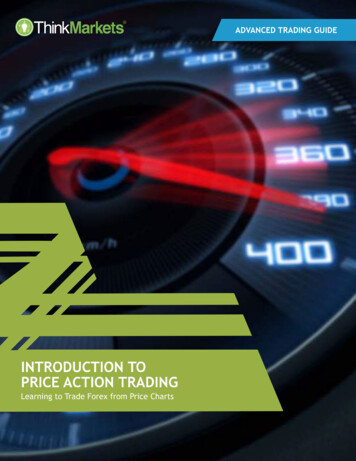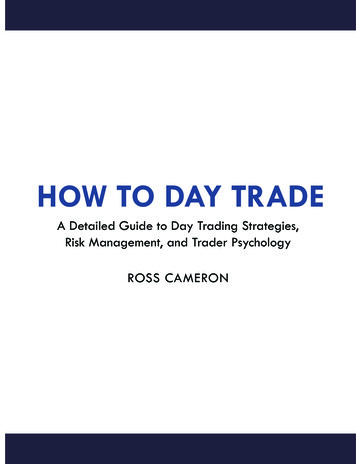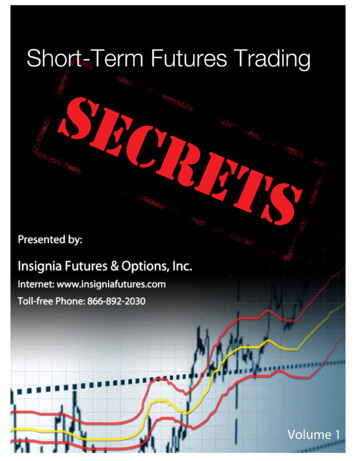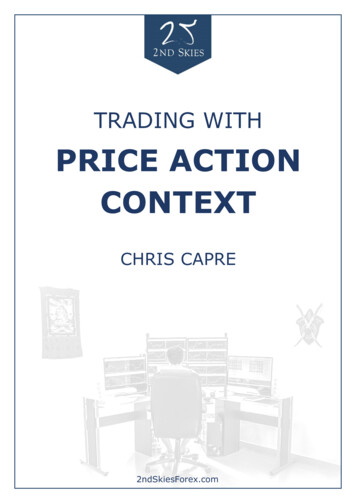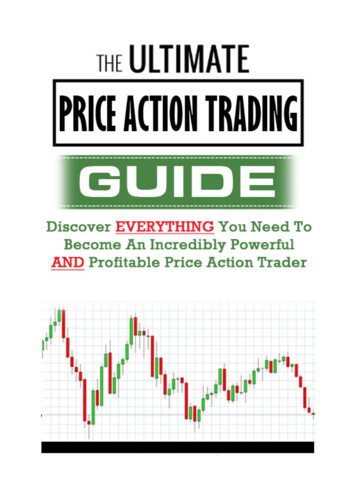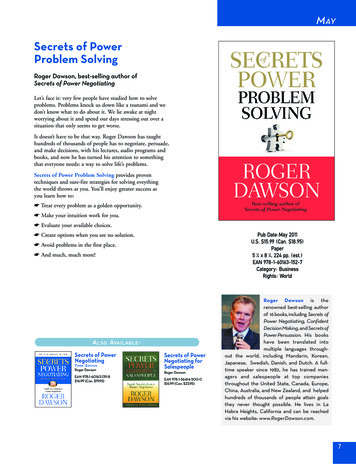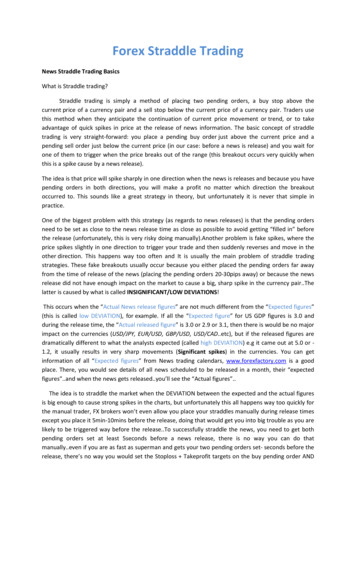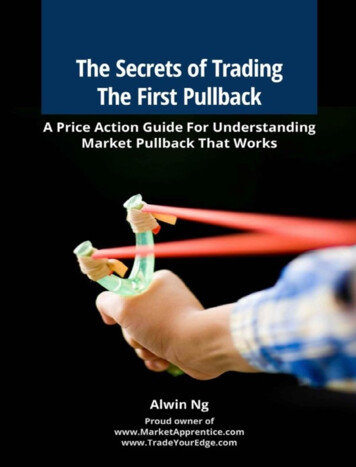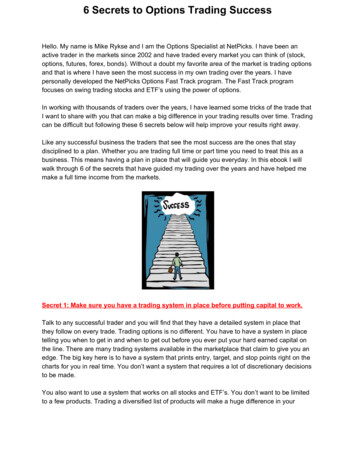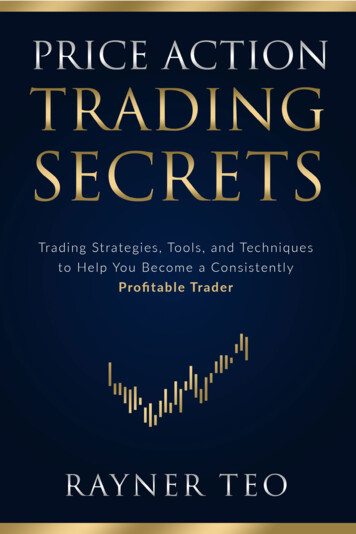
Transcription
1
2
price actiontradingsecretsTrading Strategies, Tools, and Techniquesto Help You Become a ConsistentlyProfitable Traderrayner teo3
Copyright 2020 by Rayner Teo.All rights reserved. No part of this publication may be reproduced,distributed, or transmitted in any form or by any means, includingphotocopying, recording, or other electronic or mechanicalmethods, without the prior written permission of the publisher,except in the case of brief quotations embodied in critical reviewsand certain other noncommercial uses permitted by copyrightlaw. For permission requests, write to the publisher, addressed“Attention: Permissions Coordinator,” at the address below.TradingwithRayner Pte Ltd.www.tradingwithrayner.comPrinted in the United States of America.Cover Designer: Rudi Design.Layout Designer: Mala Letra Diseño Editorial / Sara F. Salomon.Editor: Barry Lyons & Renata Sielecki, and Ng Wei Jun.Chart Illustrations: www.tradingview.com and Jet Toyco.4
disclaimerThe information contained in this book is foreducational purposes only.No representation is being made that any accountwill or is likely to achieve profits or losses similar tothose discussed in this book. The past performanceof any trading system or methodology is notnecessarily indicative of future results.By reading this book, you agree that my companyand I are not responsible for the success or failure ofyour trading business.DisclaimerThe ideas I’m about to present are onesthat I’ve learned from other traders (see theacknowledgements section) and I don’t claim to bethe original source of them.5
5DISCLAIMER7INTRODUCTION13THE NATURAL LAWS OF TRADING THATNOBODY TELLS YOU23WHAT IS PRICE ACTION TRADING ANDHOW DOES IT WORK?31MARKET STRUCTURE: DECODING THESECRET BEHAVIOR OF THE MARKETS39THE TRUTH ABOUT SUPPORT ANDRESISTANCE49HOW TO MASTER CANDLESTICK PATTERNSLIKE A PRO67THE SECRET TO RISK AND TRADEMANAGEMENT79TRADING FORMULAS: HOW TO DEVELOPWINNING STRATEGIES TO BEAT THEMARKETS101ADVANCED PRICE ACTION TRADINGTECHNIQUES THAT NOBODY TELLS YOU117TRADING EXAMPLES129FINAL WORDS.135ACKNOWLEDGEMENTSTable of contenttable ofcontent6
introductionWhen I was 20 years old, I read a book on investingcalled: Buffettology. It explained how the world’srichest investor, Warren Buffet, chose companies toinvest in.I was fascinated by how a man could become sowealthy simply by picking the right stocks to holdfor the long run. Who wouldn’t be?After reading Buffettology, I was hooked. I beganlooking for anything I could find to make myself agreat investor.I read books on value investing and fundamentalanalysis. After a while, I noticed the authors keptrepeating the same three elements: Ensure the company has more assets thanliabilities. Ensure revenue, net income, and cash flow areincreasing every year. Ensure the company has growth potential.Et voilà: The secret to successful investing!The first stock I bought was Sembcorp Marine in2009 because it had solid fundamentals and themarkets were recovering from the financial crisis.IntroductionNow, armed with my newfound knowledge, I wasready to pounce on any opportunities that appearedon the markets.7
I went long at 3.28 and told myself to hold thisstock until the price doubled!Five days later, I bailed out at 3.08. What a chickenI was.Then, after some reflection, I realized my emotionshad triggered this action. So, unwilling to give upjust yet, and with the markets making a bull run, Iknew I had to get back in the game.Being naive and ambitious, I did more research andbought more companies—with margin.Here’s what I bought: I went long on Noble Group,Keppel Land, and Sembcorp Marine with an initialoutlay of 20,000.In two months, I was up close to 10,000. But beinga fundamentalist who was trying to emulate WarrenBuffet, I held on.At this point, I felt like a champion with a knack forpicking stocks. Even my broker commented thateverything I touched turned to gold.Two weeks later, my 10,000 in unrealized profitsvaporized. The euro debt crisis had hit the markets.Now I had nothing to show but my bitterness.Eventually, I bailed out of all my positions because Icouldn’t bear the pain of watching my profits turnedinto losses.Because I was new to forex trading, I looked to theInternet for help. I browsed forums, books, andwhatever I could get my hands on.IntroductionAfter my failed attempt at being an investor, Ifigured being a trader would be better—andthat’s when I started trading on the forex (foreignexchange) market.8
My first taste of trading came when I was learningfrom a “guru” (on an online forum). He had a hugefollowing and many traders worshipped him like agod.I figured, they can’t all be wrong, can they? So Ilearned from him too.He taught us to use Bollinger Bands, to buy at thelows and sell at the highs. I traded this strategy for awhile and made money at the start, only to lose it alllater.Then, I came across a quote that said something likethis: “Indicators are useless because they lag behindthe markets. Focus on price instead.”This led me to the world of price action trading. Ilearned about support and resistance, trendlines,candlestick patterns, and many other things.Again, I had a few winning trades at the start, butslowly, the losses came and eroded all my profits.At this point, I wondered to myself, “Maybe thestrategies I’m using are too simple. I need to findsomething more complex so the chances of itworking will be higher.”This brought me to the world of harmonic patternswhere I learned about stuff like the Gartley, the Crab,the Shark, the Cypher, etc. (I’m not kidding. Thosewere the actual names of the patterns).Again, the results were the same and the cyclerepeated itself for four-plus years.After years of trial and error, I finally realized mymistake. It wasn’t the strategies, the systems, or thechart patterns.IntroductionAt that point, I was frustrated and confused. I askedmyself, “What the heck are the profitable tradersdoing that I’m not?”9
Rather, my mistakes were rooted in my lack ofunderstanding of the natural laws of trading. Ifought against these laws and paid the price. Butwhen I finally embraced them, my trading changedforever.Today, I manage a seven-figure portfolio, tradeacross forex, stocks, and ETFs, and have more than100,000 traders following my TradingwithRaynerblog each month. What a ride!So you might be wondering, “If you’re so good, whywrite a book and give away all your secrets?” That’sa great question. Here’s why: There are no secretswhen it comes to trading.If you’re talking about price action trading (ordiscretionary trading), then there are no secretssince most of the information can be found in books,courses, and online sources.Also, price action trading is subjective. The way youinterpret a chart will naturally be different from theway another trader sees it. For example, if you askedfive traders to draw support and resistance lines,you’d likely get five different answers. This meansthat even if something is a secret, the subjectivenature of price action trading will affect the waypeople interpret that secret.And this brings me to the question: If there are nosecrets in price action trading, then why write abook about it? Well, there are three reasons. Here’sthe first one:Here’s the truth. Writing a book will make me moremoney and diversify my sources of income. Also, ifyou think my book is good, there’s a good chanceyou’ll sign up for my premium training programsin the future (and that will make me even moremoney).IntroductionIt will make me more money.10
Here’s the second reason:It will inspire my children.I want my children to know that they can achieveanything they set their minds to. If Papa can write abook, so can I. If Papa can be a trader, so can If Papacan do it, so can I!And here’s the third:I’ll be able to leave behind a legacy.In the end, I want to leave something behind in thisworld. Call it a legacy, sheer ego, or whatever. I justwant to be remembered even after I’m gone. And toachieve this, I must write a damn good book so I’llbe remembered—and I hope Price Action TradingSecrets is the kind of book that will be remembered.There you have it! Those are the reasons why I wrotePrice Action Trading Secrets, and I hope you get asmuch value out of reading it as I’m getting out ofwriting it. So let’s kick things off!HERE’S WHAT YOU’LL LEARNIN PRICE ACTION TRADING SECRETS: How to trade the markets without relying onfundamentals news, trading indicators, or signalservices. How to better time your entries and exits so youcan reduce your losses and maximize your profits. How to identify profitable trading opportunitiesacross different markets and time frames. How to manage your risk like a professional traderand never blow up another trading account.Introduction How to trade along the path of least resistance soyou can improve your winning rate and increaseyour profit potential.11
How to remain calm in your trading even if themarket “throws surprises” at you. A proven framework you can use to become aconsistently profitable trader (even if you have notrading experience). Advanced price action trading techniques thatnobody tells you.There are also bonus resources that accompany thisbook to enhance your learning experience. You canget them at priceactiontradingsecrets.com/bonus.Finally, if you want to succeed in this business, nevertrust anything and always verify everything becauseno one is going to do the work for you. Cool?IntroductionThen let’s roll!12
Let me ask you this: When you throw an Apple, whathappens next? Well, it’s only a matter of time beforethe Apple drops to the ground, right? That’s becausethe law of gravity is at play here.And it’s the same with trading. Certain laws governprofitable trading, and if you break them, it’s nearlyimpossible to become a consistently profitabletrader.So here are the natural laws of trading you thatneed to embrace if you want to become a profitabletrader.The natural laws of trading that nobody tells youThe NaturalLaws of TradingThat NobodyTells You13
FOLLOWING A CONSISTENT SET OF ACTIONSLEADS TO CONSISTENT RESULTSI know this sounds like a no-brainer, but it’s true. Youmust follow a consistent set of actions if you wantconsistent results.This is easier said than done because when youencounter a losing streak, you’ll have the urge to dosomething about it.You’ll have thoughts like this:“Let me remove my stop loss so I don’t get stoppedout.”“Let me double down so I can recoup my lossesquickly.”“This strategy is not working anymore, let me findsomething else.”The bottom line is this: If you want to become aconsistent trader, you must have a consistent set ofactions.YOU MUST HAVE AN EDGEIN THE MARKETSNow, even if you are consistent in your actions, thisdoesn’t mean you’ll be a consistently profitabletrader. Why?Because your trading strategy must provide youwith an edge in the markets. What do I mean byhaving an edge?Let me give you an example:The natural laws of trading that nobody tells youAnd if you give in to your thoughts, you won’t beconsistent in your strategy—which means you won’tget consistent results.14
Let’s say I make a bet with you. Every time you tossa coin, and it comes up heads, you win 2. And if itcomes up tails, you lose 1.In the long run, you’ll make money with thisarrangement because you have an edge over me.And it’s the same with trading. If you want to profitfrom the markets in the long run, your tradingstrategy must give you an edge.This is because without an edge, even if youhave the best risk management, discipline, andpsychology, you’ll still be a losing trader.THE LAW OF LARGE NUMBERSThis is an important concept to grasp. The law oflarge number states that in the short run, yourresults are random, but they’ll align towards itsexpectancy in the long run.Let’s say you toss a coin 10 times and you get 6heads and 4 tails. Would you claim the coin has a60% chance of coming up heads and a 40% chanceof coming up tails? Of course not.Intuitively, you understand this because you onlytossed the coin 10 times. But if you were to toss thecoin 1000 times, it would be closer to 50% heads and50% tails.And this is what the law of large numbers is about.In the short run, your trading results are random.And it’s only in the long run, after a decent samplesize of trades, that your system will align toward itsexpectancy.This is important to understand because if you’reunaware of it, you’ll abandon your trading strategyThe natural laws of trading that nobody tells youI know that sounds confusing so let me give you anexample.15
after a few losing trades without understandingthat the results you’ve been observing are actuallyrandom.ALWAYS TAKE CAREOF YOUR DOWNSIDEThe most important rule of trading is to play greatdefense, not great offence. — Paul Tudor Jones.Here’s the thing: Your trading strategy can havean edge in the markets, but without proper riskmanagement, you’ll still blow up your tradingaccount.Let me give you an example.Imagine there are two traders, John and Sally.John is an aggressive trader, and he risks 25% of hisaccount on each trade.Sally is a conservative trader, and she risks 1% of heraccount on each trade.Over the next 8 trades, the outcomes are lose, lose,lose, lose, win, win, win, win.Before you think this is an unlikely scenario,remember the law of large numbers?So here’s the outcome for John:-25% -25% -25% -25% BLOW UPHere’s the outcome for Sally:-1% -1% -1% -1% 2% 2% 2% 2% 4%Are you getting the hang of how important this is?The natural laws of trading that nobody tells youBoth adopt a trading strategy that wins 50% of thetime with an average risk-to-reward ratio of 1:2.16
Risk management can be a deciding factor inwhether you’re a consistently profitable trader or alosing trader.Remember, you can have the best trading strategyin the world. But without proper risk management,you will still blow up your trading account. It’s not aquestion of if, but when.YOU NEED MONEY TO MAKE MONEYSorry to burst your bubble, but you need money tomake money in this business. Here’s why.Let’s say you make an average of 20%/year. On a 1,000 account, you’ll make 200/year. On a 100,000 account, you’ll make 20,000/year. On a 1M account, you’ll make 200,000/year.Now, you might think that 20% a year is too low andthat you can make 100% a year.Don’t believe me? Then ask yourself, why do hedgefunds raise millions (or even billions) of dollars?Why don’t they just trade their own money withouthaving anyone to answer to? It’s because they wantyou to be rich and make this world a better place.Hmm.YOU MAKE BIG MONEY BYCOMPOUNDING YOUR RETURNSSure, you can make a living trading full-time. Butif you want to make big money, then you mustcompound your returns. Let me give you anexample.The natural laws of trading that nobody tells youSure, that’s possible by taking huge risks. But I’mtalking about making consistent returns, not “gobig-or-go-home” kinds of returns.17
Let’s say you make an average of 20% a year witha 100,000 account. Every year, you use all yourtrading profits to sustain your lifestyle. This meansyou’re back at 100,000 at the start of the next year.But what if you have a job or business that coversyour expenses so you don’t have to withdraw moneyfrom your account. How would this change things?Let’s use my example again.You make an average of 20% a year on a 100,000account, but if you don’t withdraw your profits, youcan compound your returns over time. After 10 years,your account will be worth 619,173. After 20 years,it will be worth 3,833,759. After 30 years, it will beworth 23,737,631. You get my point.But do you know where the biggest money ismade? Other people’s money (OPM). Yup, you readme right. The biggest money is made by managingother people’s money. But don’t take my word forit. Just look at the richest finance people on Forbes,and you’ll see that most of them own hedge funds.And what do hedge funds do? They manage otherpeople’s money.This is one of the most common questions I getfrom traders: “Hey Rayner, what is the best tradingstrategy out there?”I’ll be honest. There’s no such thing as the besttrading strategy because it’s not possible to definewhat “best” means. “Best” could mean many things:highest returns, lowest drawdown, least timerequired, low capital requirements, the list goes on.Clearly, what’s “best” to you might seem terrible tosomeone else.So instead of looking for the best trading strategy,you first have to know what your trading goals are.Once you understand that, you can select the “best”trading strategy to meet your goals.The natural laws of trading that nobody tells youTHERE’S NO BEST TRADINGSTRATEGY OUT THERE18
NO TRADING STRATEGYWORKS ALL THE TIMETrading strategies seek to exploit certain “patterns”in the markets. If you want a trading strategy towork all the time, market conditions must remainthe same.But ask yourself, is this possible? If you’ve tradedlong enough, you’ll know it’s not because themarket is always changing. It can move from anuptrend to a downtrend, low volatility to highvolatility, and so on.And if the markets are always changing, then itmeans no trading strategy works all the time (andthis is how a drawdown occurs).So forget about using a single trading strategy tomake money every day (or every week). It doesn’twork that way.THE SECRET TO MAKINGPROFITS EVERY DAYThis is the secret to making daily profits: Thefrequency of your trades. Yes, you read me right. Ifyou want to make money every single day, you needto trade frequently so the law of large numbers canwork in your favor (within a short time frame).Confused? No worries, I’ll explain. Imagine thefollowing scenario: You have a special coin in your hands. If it comes up heads, you win 2.The natural laws of trading that nobody tells youInstead, you’ll go through a cycle of ups and downs.You want to keep your profits during the good timesso you can pay for your losses during the bad. Thekey is to play good defense so you can survive toexperience the good times again.19
If it comes up tails, you lose 1.But here’s the catch: You can only toss your coinonce a day. Do you think you’ll be able to makemoney every single day doing this?Of course not. Why? Because in the short run, yourcoin toss results are random—you could get tailsmany times in a row (and thus lose many days in arow).Now, what if you could toss your coin 1,000 times aday? How would the results change? Well, you’d getclose to 50% heads and 50% tails after 1,000 tosses—which means you’d be guaranteed to make moneyevery day because your edge could play out within ashort period of time.Does this make sense? Great! Because this conceptis the same as trading. If you want to make moneyevery day, you must have a high frequency of trades.That’s why this field is largely dominated by highfrequency trading firms, and yes, they can makemoney (almost) every day. One example is VirtuFinancial, which according to Bloomberg, had oneday of trading losses in 1,238 days (during the 2009–2014 period).So does this mean you can’t trade for a living? Nope,it doesn’t mean that. It means you shouldn’t expectto make money every single day—and this isn’t tosay that you can’t make money every quarter orevery year.The natural laws of trading that nobody tells youBut is this feasible for a retail trader? In myopinion, the odds are stacked against you becausecommissions are sky high, and it’s unlikely you’llbe able to (consistently and profitably) spot asufficiently high number of trading opportunitieswith your naked eye alone.20
TRADING IS A GET-RICH-SLOW SCHEMEMany people get involved in trading because theywant to make money—and they want to make itfast. But I’m here to tell you trading is a get-rich-slowscheme.Sure, you can make money fast, but you’ll lose itequally as fast (or faster). So if you want longevity inyour career, treat trading as a business (not a getrich-quick scheme).Here’s how it works:If you start with a 5,000 account, and you make anaverage of 20% a year, after 20 years, your accountwill be worth 191,688.But let’s take things a step further. Let’s add another 5,000 to your account every year. Again, if youmake an average of 20% a year, after 20 years, it’ll beworth 1,311,816.So my suggestion is to risk small, add more fundsregularly, and compound your way to riches. Yes,it takes time, but the risk of ruin is dramaticallyreduced.The natural laws of trading that nobody tells youHow “fast” you can get rich depends on two things:your account size and your percentage return. Sure,you can increase your return by risking more, butthe risk of drawdown is larger—and you risk losingeverything.21
AT THIS POINT You’ve learned the natural laws of trading and howthey work. This will give you a good idea of whatprofitable trading is about so you can ignore the noiseand focus on the stuff that matters.Next, we’ll look at the basics of price action trading.You’ll learn what it is, why it matters, and what its prosand cons are.SUMMARY If you want to be a consistent trader, you must beconsistent in your actions. You must have an edge in the markets becausewithout one, even the best risk management ortrading psychology won’t save your account. The law of large numbers means your trading resultswill be random in the short run. In the long run,they’ll align towards its expectancy. Always take care of your downside. The best tradingstrategy is useless if you don’t contain your losses. The big money is made from compounding yourreturns, and the biggest money is made frommanaging other people’s money (OPM). There’s no such thing as the best trading strategybecause “best” is subjective. No trading strategy works all the time because themarkets are always changing. Trading frequency matters. Don’t expect to makemoney every day if you only take two trades per day. Trading is a get-rich-slow scheme. If you add fundsto your account regularly and compound them overtime, you’ll eventually get rich—but it takes time.The natural laws of trading that nobody tells you You need money to make money in this business.22
What is PriceAction Tradingand How Doesit Work?Let’s say there are 100 buyers, each wanting to buyone share of Google. At the same time, there’s oneseller, but the seller wants to sell one million sharesof Google.What do you think would happen to the price?Would it go up or down? It’ll go down because theselling pressure is greater than the buying pressure.This has nothing to do with there being more buyersthan sellers because, in this case, there are morebuyers than sellers. But the price is still going downbecause the selling pressure is greater.And this is what price action trading is about:Understanding the imbalance between buying andselling pressure so you can better time your entriesand exits—and improve your trading results.What isPriceAction Tradingand HowDoes it Work?Here’s the deal: Most traders think the price goes upbecause there are more buyers than sellers. Nope.Here’s why.23
So what are the benefits of price action trading? You can ignore fundamental news because priceis all you need. Unlike trading indicators, the price is the price. You can better time your entries and exits. You have a framework to trade in different marketconditions.Let me explain this further.YOU CAN IGNORE FUNDAMENTAL NEWSBECAUSE PRICE IS ALL YOU NEEDNow, you might be thinking, “But Rayner,fundamentals are what drive the market. How can Iignore them?”Let me ask you, have you ever noticed how themarket goes down when there’s bad news and upwhen there’s good news?AMD stock had negative earnings in 2014, 2015,and 2016. But the stock price still gained 700% in 12months.What isPriceAction Tradingand HowDoes it Work?Here’s an example:24
If you were trading based on the news, you probablygot burned and missed the monster rally.But what if you ignored the news and just followedprice? How would that turn out?Since we’re on this topic, let me tell you a secret.Have you ever wondered how financial news alwayshave a reason for the market ups and downs?It’s because they have a slew of positive andnegative news on standby. If the market is up, theychoose to share the positive news. And if it’s down,they focus on the negative news.That’s why there’s always positive and negativefundamental news floating around. And the typeof news that’s shared is dictated by the pricemovement, not the other way around.Have you ever heard a news reporter say, “I have noidea why the market went down today.”THE PRICE GIVES YOU AN OBJECTIVE VIEW OFTHE MARKETS (WITHOUT MANIPULATION)Most trading indicators work by applying a formulato the price. For example, a 200-day moving averagecalculates the average closing price over the last 200days.Now, there’s nothing wrong with using indicatorsin your trading, provided you understand how theywork.But if you don’t, you’ll be manipulated by tradingindicators.Let me give you an example. The relative strengthindex (RSI) indicator shows oversold on the dailyWhat isPriceAction Tradingand HowDoes it Work?Nope, it never happens. They always know the causebecause they have a list of “reasons” to choose from.25
timeframe. But if you “adjust” the settings, you canchange the RSI to overbought.That’s because the RSI calculates the average gainsto losses over a fixed number of periods. And if youadjust the number of periods, you’ll get a differentRSI reading.So which settings do you trust? The overbought or theoversold RSI? And there lies the problem. If you’re notcareful, you can manipulate indicators to fit your bias(and that’s a recipe for disaster).Now, what about price action? Well, the price isthe price – and what you see is what you get. Noformulas, no “adjustment,” and less manipulation.(I say less manipulation because in less liquidmarkets, the price can still be manipulated by thosewith deeper pockets).YOU CAN BETTER TIME YOUR ENTRIES AND EXITSThis means when you use price action to time yourentries and exits, you’ll be faster than someone whorelies on indicators.But remember, just because indicators lag, doesn’tmean they’re useless because they’re a great tool tofilter your trading setups, trade management, etc.Now, it’s beyond the scope of this book to discussindicators. But if you want to learn more, thendownload the PATS bonus resource, where you’lllearn how to use indicators effectively. Here’s thelink: priceactiontradingsecrets.com/bonusWhat isPriceAction Tradingand HowDoes it Work?As you know, trading indicators work by applyingmathematical formulas to the price. So they’reslower to react, and that’s how you get the saying“indicators lag behind the market.”26
YOU HAVE A FRAMEWORK TO TRADEIN DIFFERENT MARKET CONDITIONSImagine you wanted to build a house. Would yourandomly install the doors, toilet bowls, bathrooms,and bedrooms whenever you felt like it?Of course not. You’d have a framework (or blueprint)so you’d know the layout and design of your house.Only then, would you execute the work on yourhouse.It’s the same for trading. You don’t just blindly placebuy and sell orders whenever you feel like it. Youmust have a framework for trading the markets thatincludes a plan for when to buy, when to sell, andwhen to stay out of the markets.That’s how price action trading comes into playbecause it helps you to identify the different marketconditions so you can use the appropriate tradingstrategy to respond to them. And when the marketchanges, so should your trading strategy. It’s near impossible to perform an accuratebacktest. It takes a lot of time to validate a trading strategy. There’s subjectivity involved.Let me discuss these points in more detail.IT’S NEAR IMPOSSIBLE TO PERFORMAN ACCURATE BACKTESTWhen you backtest discretionary trading strategies,you’re looking at historical data and “pretending”that you’re trading live.What isPriceAction Tradingand HowDoes it Work?At this point, you’re all excited about mastering priceaction trading. But wait. Before you begin, I want toshare the downsides of price action trading with youso that you’re aware of them:27
You scroll through the charts until you’re looking atthe earliest possible date, and you unfold each barone by one, simulating what would happen as if it’soccurring in real-time.Then, you decide whether you’ll enter or exit yourtrades according to your strategy—and record theperformance over the backtest period.Now, the problem with this approach is that yourbias will skew your results.For example, if you see that bitcoin is in an uptrendfrom 2015 to 2017, your bias will be on the long side(and you’ll avoid shorting).In addition, you’ll be more likely to make errors inrecording the result of each trade, which will makethe results less reliable.IT TAKES A LOT OF TIME TO VALIDATEA TRADING STRATEGYHowever, for long-term traders, this may take ayear or two. If you’re going down this path, it makessense to have a full-time job and do this part-time soyou reduce your opportunity cost.THERE’S SUBJECTIVITY INVOLVEDPrice action trading falls under discretionarytrading. And when you trade in this manner, there’ssubjectivity involved.For example, if you ask two traders to identifypatterns on a chart, you’ll get two different answers.Why? It’s because they each have their owninterpretation of the market based on their ownexperiences and biases.What isPriceAction Tradingand HowDoes it Work?The alternative to backtesting is forward testing.Instead of looking at past data, you trade live andsee how your trading strategy performs in real-time.If you’re a short-term trader, you’ll be able to get adecent sample size of trades within a few months.28
That’s why as a price action trader, it’s importantto have a framework you can use to minimizesubjectivity (and that’s what this book is all about).What isPriceAction Tradingand HowDoes it Work?Now, you can’t avoid subjectivity entirely. But it issome
when it comes to trading. If you're talking about price action trading (or discretionary trading), then there are no secrets since most of the information can be found in books, courses, and online sources. Also, price action trading is subjective. The way you interpret a chart will naturally be different from the way another trader sees it.
